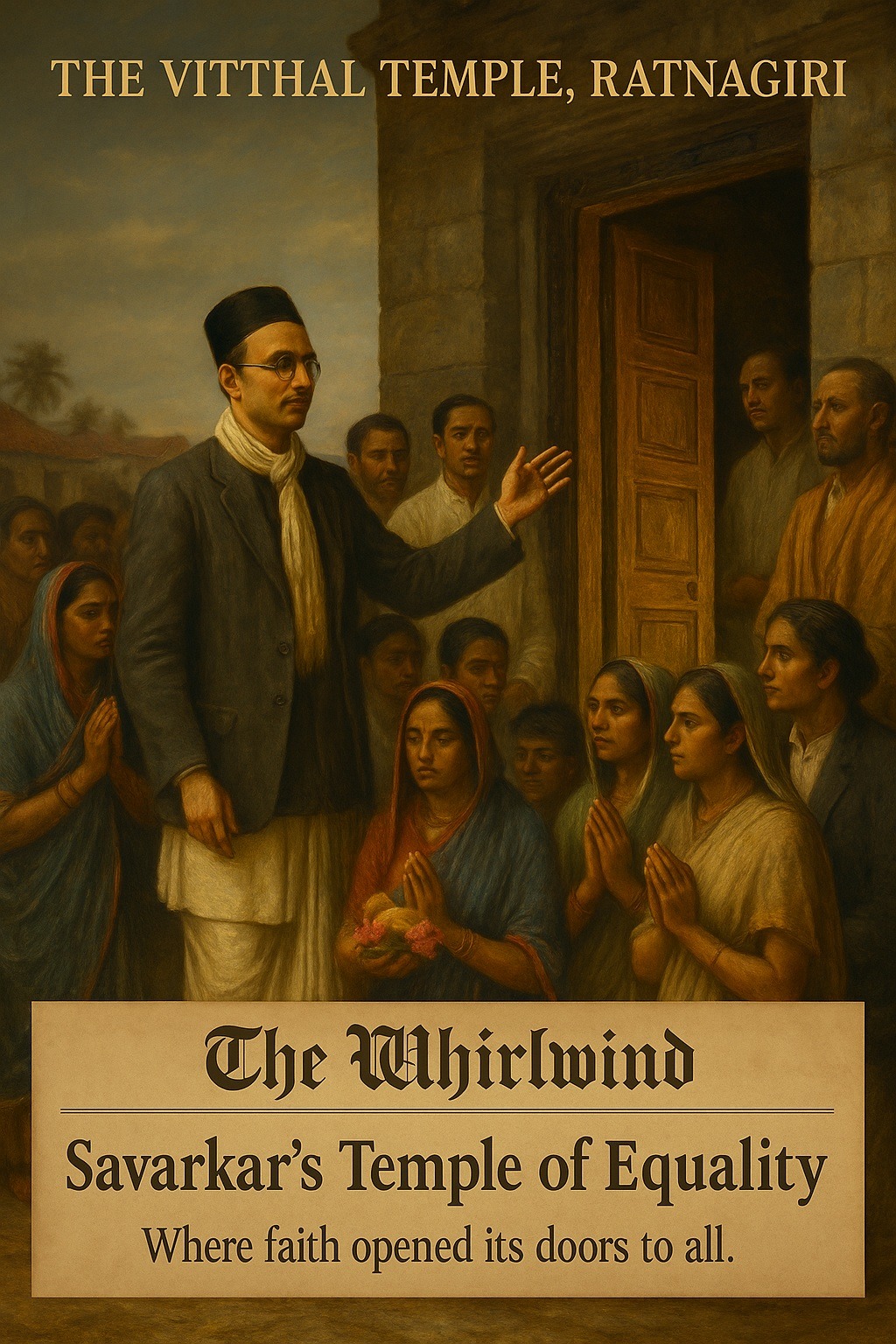The Vitthal Temple in Ratnagiri, located in Maharashtra’s Konkan region, became one of the most symbolically charged sites in early 20th-century Hindu social reform. Dedicated to Lord Vitthal (‘Vithoba’) – a form of Vishnu-Krishna revered as the deity of the common people – the temple held both religious and social significance for the local Hindu community. Traditionally, however, entry to its inner sanctum was restricted to members of the so-called “higher” castes, reflecting the rigid hierarchies that dominated Hindu practice at the time.
Savarkar’s Intervention and the Reform Context
When Vinayak Damodar (Veer) Savarkar was released from the Andaman Cellular Jail in 1924 and placed under internment in Ratnagiri, he redirected his revolutionary zeal toward Hindu social reconstruction. He believed that political freedom would be hollow without social emancipation. Among the most entrenched injustices he confronted was untouchability, which excluded large sections of Hindus – particularly the Mahar and Mang communities—from religious participation and public life.
Savarkar saw temples as the symbolic heart of Hindu society. To exclude people from worship, he argued, was not merely a social wrong but a moral and civilizational failure. Thus, reforming temple access became central to his broader project of Hindu Sanghatan (Hindu consolidation and unity).
The 1929 Vitthal Temple Entry Movement
The turning point came in March 1929, when Savarkar and his associates organized a “Samajik Samata Sangh” (Social Equality Conference) and a “mixed mela” at the Vitthal Temple. For the first time in Ratnagiri’s history, members of the so-called “untouchable” castes were formally invited to enter the temple and offer worship.
The event was conducted peacefully, with the support of reform-minded citizens, though it met with opposition from orthodox elements who viewed it as a desecration. Savarkar, however, defended the act as both religiously legitimate and socially necessary, grounding his argument in Hindu scriptures that affirmed the divine essence in all beings.
The opening of the Vitthal Temple thus became a landmark moment in India’s temple entry movement – predating and inspiring later efforts, such as the Vaikom Satyagraha in Kerala and other regional reform initiatives.
Symbolism and Legacy
The Vitthal Temple reform was more than a local event – it was a microcosm of Savarkar’s vision for a rejuvenated Hindu society. By enabling access to the temple, Savarkar was asserting that the divine belongs to all, regardless of caste or birth.
In his speeches and writings, he often linked the temple movement to the concept of “Samajik Samarasata” (social harmony)—a vision of Hinduism that was rational, inclusive, and rooted in ethical action. The Vitthal Temple thus became a living emblem of “sacred space, shared humanity”, a phrase that captures both the spiritual and humanistic dimensions of Savarkar’s reformist mission.
Final Thoughts – Today’s Legacy
While the original Vitthal Temple in Ratnagiri remains modest in scale, its historical resonance endures. It stands not merely as a site of worship but as a symbol of social awakening—a reminder that faith, when guided by conscience, can serve as a force for liberation rather than exclusion.
💭 What do you think? How do you see Savarkar’s approach to temple entry reform compared to other social reformers of his time? Do you think social equality movements rooted in religion are more effective than purely political ones? Why or why not? Savarkar argued that “political freedom is hollow without social emancipation.” — Do you think this holds true in modern India? Can temples and other religious institutions today still serve as spaces for social reform? How might the legacy of the Vitthal Temple Entry inspire current efforts toward caste and class equality?
👉 Share your thoughts in the comments below!
Sources:
GODBOLE, Gopal. Savarkar: Father of Hindu Nationalism. Pune: S. Chand, 1980.
KEER, Dhananjay. Veer Savarkar: Father of Hindu Nationalism. Bombay: Popular Prakashan, First Edition 1950; Revised Edition 1966.
MEHTA, N. C. Savarkar and His Times. Bombay: Veer Savarkar Prakashan, 1959.
PATIL, V. V. Savarkar: A Study in the Evolution of His Political Thought (1900–1924). New Delhi: Sterling Publishers, 1983.
SAMPATH, Vikram. Savarkar: Echoes from a Forgotten Past, 1883–1924. New Delhi: Penguin Viking, 2019.
SAMPATH, Vikram. Savarkar: A Contested Legacy, 1924–1966. New Delhi: Penguin Viking, 2021.
WOLF, Siegfried O. 2009. Vinayak Damodar Savarkar und sein Hindutva-Konzept. Die Konstruktion einer kollektiven Identität in Indien [“Vinayak Damodar Savarkar and his concept of Hindutva: The construction of a collective identity in India.”]. Online Dissertation: Heidelberg University: Heidelberg.


Leave a Reply